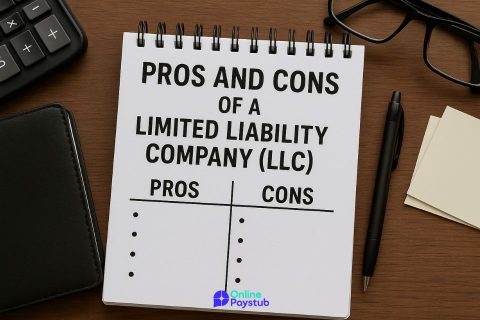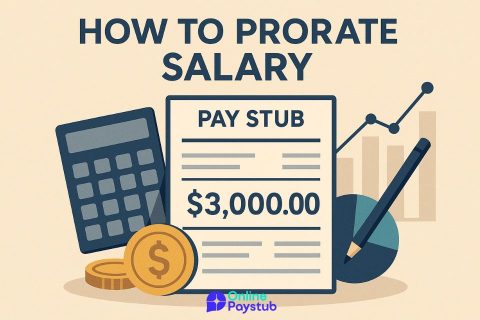In today’s financial landscape, documentation is more than a formality it’s a necessity. Whether applying for a loan, renting an apartment, or navigating immigration requirements, individuals are routinely asked to verify their employment status. But what exactly does that mean? And more importantly, how do you prove it?
For professionals in finance and human resources, one tool stands out as both essential and misunderstood: the employment verification letter. While it might seem like a straightforward document, the reality is that these letters often serve as a key piece of evidence in decision-making processes involving banks, landlords, and government agencies.
This article examines the purpose, structure, legal boundaries, and practical uses of employment verification letters. It also offers insight into how to create one accurately and how digital tools like pay stub makers have streamlined this process for employers and employees alike.
Why Employment Verification Letters Matter in Finance and HR
Employment verification letters are more than administrative paperwork. In both financial and HR settings, they function as a formal attestation of an individual’s current or past job status, income, and role within an organization. Financial institutions, landlords, and even government bodies often rely on these documents to make risk-based decisions. Without a credible employment record, access to housing, credit, or residency approvals may be delayed or denied entirely.
From a finance perspective, these letters serve as an early signal of repayment ability. Mortgage lenders, for instance, frequently request job verification documents to validate a borrower’s income consistency and employment stability. In corporate finance, internal audits or external compliance reviews may also depend on accurate employment records to ensure proper classification of wage expenses.
For HR departments, the verification letter serves a dual function. It not only confirms an employee’s official status but also protects the company from disputes related to misrepresented employment. Properly written, it reduces legal risk while fulfilling due diligence responsibilities in various employment or termination scenarios.
Despite their significance, the process of drafting such letters often lacks standardization. Inconsistent formatting, incomplete data, or omission of key details can undermine their reliability. That’s why organizations increasingly turn to digital solutions like pay stub makers and automated HR systems to ensure every verification aligns with legal and professional expectations.
What Does an Employment Verification Letter Typically Include?
An employment verification letter is only as valuable as the information it contains. For the letter to serve its intended purpose whether for financial validation, legal documentation, or HR compliance it must follow a precise structure and include specific data points. Omissions or vague language often result in delays or rejection from the requesting institution.
At a minimum, a professionally drafted employment verification letter should contain:
- Full name of the employee
- Job title and department
- Dates of employment (start and, if applicable, end date)
- Employment status (full-time, part-time, or contract)
- Annual or monthly salary, if requested
- Employer’s official name and address
- Contact information of the verifying authority (usually HR or management)
- Signature and company letterhead
Including salary information is sometimes optional but often requested by banks, loan officers, or visa authorities when verifying income for a mortgage, financial aid, or residency application. In those cases, omitting earnings data may render the letter unusable.
Consistency also matters. Financial institutions typically cross-reference employment verification letters with submitted pay stubs, W-2s, or bank statements. Discrepancies between these documents can raise red flags and slow down approval timelines.
Who Writes It and Who Can Request It?
The responsibility for writing an employment verification letter typically lies with the employer but exactly who within the organization handles it can vary. In most cases, it is issued by the Human Resources department or an authorized manager, especially when the letter requires sensitive details such as income or job performance history.
While employees themselves may draft a preliminary version, such self-generated letters are rarely accepted without formal validation. For example, a self-employed individual may need to submit alternative documents such as tax filings, business licenses, or third-party accountant statements, which serve as indirect employment proof.
From the requester’s side, verification letters are most commonly sought by:
- Financial institutions: for loans, credit approvals, mortgage underwriting
- Landlords or property managers: to assess tenant stability
- Government agencies: especially for immigration, tax audits, or benefit eligibility
- Prospective employers: during background checks
- Legal representatives: in case of disputes, claims, or compliance reviews
It’s also worth noting that some organizations have internal policies restricting who can issue such documents. Unauthorized letters even if factually correct may be dismissed by external parties. For this reason, many companies centralize the verification process through HR or compliance teams and discourage department heads from issuing ad hoc letters.
Formal requests usually come with a template or checklist from the requesting entity, detailing exactly what information is needed. Ignoring these instructions may lead to returned documents, which in high-stakes situations like mortgage underwriting, can cause critical delays.
When and Why You Might Need One
Employment verification letters are typically requested during high-stakes transactions where proof of income, job stability, or legal status is necessary. While the need may appear bureaucratic, the rationale behind it is rooted in risk mitigation. Financial and legal institutions require these documents to validate claims and reduce exposure to default, fraud, or regulatory noncompliance.
Here are the most common scenarios where an employment verification letter becomes essential:
- Mortgage or Loan Applications
Lenders need to confirm that the applicant has a stable source of income to meet repayment obligations. Letters that include salary, job duration, and employment type are often non-negotiable parts of the approval process. - Rental Agreements
Property managers assess the financial reliability of prospective tenants. A formal letter stating current employment and salary gives landlords assurance that rent payments can be met regularly. - Visa and Immigration Processes
Many embassies require documented proof of employment to evaluate visa eligibility. The letter demonstrates financial independence or ties to a home country, depending on the type of visa requested. - Government Benefits or Legal Claims
In cases involving unemployment benefits, tax audits, or legal disputes, a well-structured employment letter serves as evidence. It may be used to determine eligibility, assess liability, or validate historical data. - Background Checks for New Employment
Some employers, especially in regulated industries, request verification from previous employers to validate resume claims and employment history.
The timing of such requests often aligns with application deadlines or regulatory filings. A delayed or incomplete letter can interrupt processes, result in lost opportunities, or raise unnecessary questions about the applicant’s transparency.
In a well-organized system, employers prepare for these scenarios in advance, often leveraging HR automation tools to generate standardized letters within minutes. For employees, understanding the strategic importance of these documents can help them request and manage employment verification proactively.
How to Create a Professional Employment Verification Letter
Creating a professional employment verification letter involves more than simply confirming a job title. A credible letter must align with legal standards, organizational formatting practices, and the expectations of the requesting institution. Poorly formatted or vague letters can erode trust and stall essential transactions.
Here is a structured approach to creating a letter that stands up to scrutiny:
1. Use Official Company Letterhead
Start with the organization’s letterhead to establish authenticity. If unavailable, include the employer’s full legal name, address, and contact details at the top of the document.
2. Address the Letter to a Specific Requestor
When possible, tailor the letter to a named recipient or organization. If unknown, a general but formal salutation such as “To Whom It May Concern” is acceptable.
3. Clearly Identify the Employee
Include the employee’s full legal name, job title, department, and unique identifiers such as employee ID (if applicable). Be precise to avoid confusion or misinterpretation.
4. Provide Verified Employment Details
State the employment start date, current status (active or terminated), and job classification (full-time, part-time, contract). If salary or compensation is requested, include the gross amount and payment frequency.
5. Include an Authoritative Signature
The letter should be signed by an authorized individual, typically someone in HR or upper management. Include their title, name in print, and direct contact information.
6. Avoid Subjective Language
Statements about work performance or personality traits fall under reference letters, not verification letters. Keep the content factual and objective.
7. Review for Legal and Formatting Accuracy
Ensure all statements are verifiable and that no confidential information is disclosed without consent. Run a spell check and align formatting with company standards.
8. Use Templates or Document Tools When Appropriate
Pre-approved templates help ensure consistency, especially when dealing with high volumes of requests. HR platforms and pay stub makers often include verification modules that auto-populate reliable data.
A well-constructed letter not only protects the organization but also empowers the employee in critical personal or financial processes. Given its legal and re
Legal Limitations and Ethical Boundaries
Employment verification letters may seem routine, but they sit at the intersection of labor law, data privacy, and institutional risk. Missteps whether intentional or not can have legal consequences for both the employer and the employee. That’s why every verification letter must balance transparency with confidentiality.
What Can Be Disclosed Legally?
Most jurisdictions allow employers to confirm factual information such as:
- Employment dates
- Job title
- Current or former employment status
- Salary (if explicitly authorized by the employee)
However, disclosing performance evaluations, disciplinary records, or medical history is typically prohibited without explicit, written consent. Employers that overstep these boundaries risk breaching data protection laws, such as the General Data Protection Regulation (GDPR) in the EU or HIPAA guidelines in the U.S. when health data is involved.
Is There a Legal Obligation to Provide One?
In general, employers are not legally required to issue employment verification letters unless mandated by a court order, collective bargaining agreement, or government inquiry. That said, refusing to provide one without clear cause may be interpreted as retaliatory or discriminatory, particularly if it interferes with an employee’s access to housing or immigration processing.
Ethical Considerations
Beyond legality, ethics play a critical role. Inflating titles, backdating employment records, or omitting termination status can mislead third parties and expose the employer to fraud claims. Similarly, employees requesting falsified letters—even for personal convenience—risk legal penalties and reputational damage.
Protecting Privacy
Best practice dictates that employers obtain written authorization before releasing any employment data. Standard HR procedures should include signed release forms, data-use disclosures, and audit logs that record when and why such documents were generated.
Organizations that process high volumes of verification letters often use document automation tools with built-in compliance checks. These systems flag inconsistencies and ensure that only authorized data is included, significantly reducing the risk of legal exposure.





No comments to show.